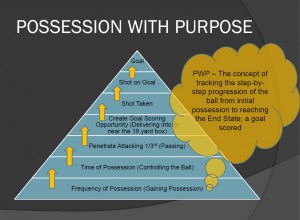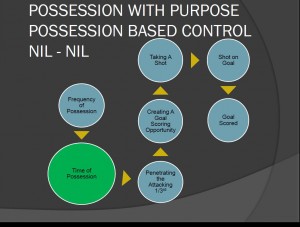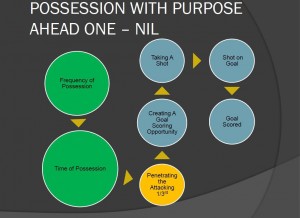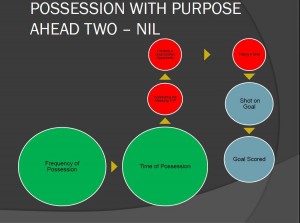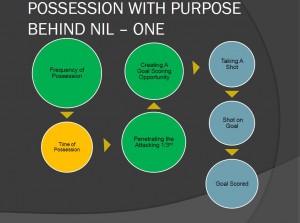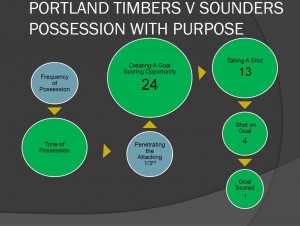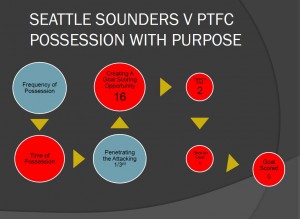Possession With Purpose (PWP) What is it and what does it mean?

INTRODUCTION: This is the original post on Possession with Purpose – it has since been updated and refined here:
Timbers closed out their pre-season activities against FC Tucson with a win this past Friday (3 – nil) and regardless of what value some place on ‘friendlies’ there is competition between players (for both teams) on who can impress their coach the most to garner more playing time as the regular season draws near.
While that won’t be the case for FC Tucson (with respect to MLS playing time) against Timbers – it was most certainly the case for Portland Timbers and Seattle Sounders players in the game last Tuesday as build-up for the regular season continues.
Many, like myself, don’t put much stock in the result of a friendly match but within the fundamentals of the game there are many real indicators that coaches might put stock in when considering who plays where and when.
For example; in just two pre-season games we have already seen Kalif Alhassan rotate from a (deep lying play-maker/holding midfielder?) role to that of a Forward (primarily down the right side). There may be another few tweaks on who plays where as the pre-season continues and I won’t offer thoughts on that yet till we see another couple of games in JELD-WEN starting from the 17th…
So what might some of those fundamentals be and how do they relate to Possession With Purpose (PWP)? Set out below are diagrams (click to enlarge) to help set the stage on those fundamentals (step-by-step activities) that occur in any game, pre-season or not, that coaches might consider:
NOTE: Time of possession includes possession of the ball anywhere outside of the attacking third; this is difficult to judge at times given the pitch isn’t broken up into thirds but quite often a team will penetrate the attacking half (how PWP has been measured before) only to pass the ball back out of the attacking half with nothing gained other than ‘possession is maintained’, or the less obvious, gaps in the opponents defense.
This is not to say these are the only fundamental steps; from a defensive standpoint a solid approach (might?) include how effective the back-four and midfielders are in preventing the step-by-step progression as the opposing team attacks.
A reasonable expectation is that a strong defensive team will do its very best to interrupt the flow of the opponent, at the earliest opportunity, in this progression. I would submit that a stronger defensive team will mean the opponent has far fewer Goal Scoring Opportunities (GSO’s), Shots taken, shots on goal and goals scored.
NOTE: A GSO, for the purpose of this analysis is defined as any ball, delivered by anyone, from anywhere on the pitch, that could lead directly to a shot taken. A successful GSO leads directly to a shot taken. An unsuccessful GSO is either due to bad placement, poor acceptance or good defending (denying the attacking player a shot taken).
My next offering is that these fundamental steps have a relationship to each other… provided below. In this instance the two colors used (green and blue) indicate that (green) Time of Possession is the over-riding focus area used to penetrate the attacking 1/3rd. While blue simply represents that these steps still remain critical in scoring a goal. I have heard Caleb Porter indicate at least a half-dozen times that possession leads to control and the more you control a game the more often you should win… (get results).
On the other hand a diagram (just below) might look like this when relying on “Direct Attacking Football”; this diagram could be used to reflect the philosophy of John Spencer. Here, penetration of the attacking 1/3rd (regardless of where and when) outweighs the importance of overall possession and control of the game; (perhaps? others have a different view?
For many years this philosophical difference in approach may have led to managerial changes or tactical strategies employed by teams that are looking to win football games depending on various conditions (home, away, weather, climate, or score-lines). However viewed the intent remains that measuring PWP is not just a function of penetrating the attacking half; it’s a comprehensive measurement that should include all these steps above.
For me a critical piece in considering this approach is looking to assess what impact the score-line might have on steps within the PWP diagram; and what increases or decreases in focus might occur (tactically) when the score-line changes.
This doesn’t mean I will ignore home versus away, weather or climate conditions. I’ll be looking into that as well but for now, with minimal data, my theory going in is that the score-line should impact the frequency of executing these steps. And the better teams will have better numbers; while the worse teams will have worse numbers. And areas of worse numbers will point out gaps in attacking or defending.
In considering these next diagrams green indicates an increase in focus while amber and red indicate a slight or marked (respectively) decrease in focus; blue indicates that the step remains critical to success regardless of score-line.
When the score-line moves from Nil-Nil to One-Nil there is a compelling need to protect the lead but not lose sight of getting more goals. So in protecting the lead it would seem reasonable that a team will increase focus on getting possession of the ball and look to increase possession time; in other words ‘defending with the ball’…
While this is not intended to decrease focus on scoring a goal it means a team is even more patient in the build-up towards penetrating the attacking 1/3rd. Hence the increased focus on frequency and time of possession with a corresponding slight decrease in penetrating the attacking 1/3rd.
If the score-line moves from One-Nil to Two-Nil then there is a need to increase pressure on the opponent and increase time of possession. This increase in frequency and time far outweighs the need to apply continued pressure in the attacking third; therefore penetration, creation of goal scoring opportunities and taking shots have a marked decrease in focus… in other words time becomes an ally.
Conversely, if the score-line is Nil – One (see below) then the team may look to increase focus on frequency of possession, as well as penetrating the attacking 1/3rd and creating GSO’s while there may be a slight decrease in focus on possession time.
How quickly a team tactically changes in working towards trying to create an equalizing goal has quite a bit to do with the overall talent of the team. In other words Manchester United might not make any tactical changes when behind by a goal until the 75th or 80th minute.
NOTE: This diagram closely resembles that of the Direct Attacking Football diagram but the sense of urgency is slightly increased by looking to convert as many attacking 1/3rd penetrations into GSO’s.
If the score-line moves from being behind by one goal to two goals then a tactical change should be expected; almost regardless of game time; again a team like Manchester United might not get their knickers in a twist if down 2-nil at the 15 minute mark but it’s a good offering that they will if down 2-nil at the 45 minute mark.
Here’s how the changes in focus might look when down 2-nil or when a team is behind 1-nil with 10-15 minutes to play.
With this diagram there is a definite increase in focus on penetrating the attacking 1/3rd as well as increasing GSO’s and shots taken on goal; the marked decrease in focus on time of possession is reflected by the much smaller red circle.
With those conditions set, here is my offering for your consideration on how the diagram above relates to the data points collected when the Portland Timbers played Seattle last Tuesday.
Portland Timbers diagram:
NOTE: I did not track Frequency of Possession and Time of Possession is an estimate based upon what I saw throughout the game. I also did not track how many times either team penetrated the attacking 1/3rd; nor have I provided an estimate; hence the blue color. Green represents where Portland Timbers exceeded Seattle Sounders statistically.
Seattle Sounders diagram:
Although this was just a friendly both sets of players from both teams are professional and are looking to get a starting job; the end result (1-nil) might not matter but the build-up in reaching the end state should.
For Portland; their average shots taken in the last two years was just over twelve, in this game they had 13 (no difference). Not much improvement yet but when viewed from a defensive angle PTFC held Seattle to just 2 shots taken; that’s a significant improvement in defending against shots taken compared to last year.
The average shots taken for all MLS teams last year was 14. Seattle only took two shots and only one of those was on-goal and it came at the ninetieth minute of play.
So in considering a PWP offensive takeaway for Portland this game there really wasn’t any; but defensively they far exceeded the average from last year.
Aye; this was only a friendly but indicators were that the Caleb Porter led Akron Zips were stingy on defense… while not the regular season those numbers certainly indicate a ‘stingy’ defense to me.
I won’t go so far as to say that Portland dominated Seattle because this was just a friendly; but a match result and data output like this in the regular season, against any team, ‘will’ have significance as opponents prepare for Portland.
A great test to begin the season comes against New York; a very rich team who is notorious, like LA, for buying ‘quality’; can less $$, but increased focus on some more tactical aspects of the game, outweigh the budget New York has expended on trying to buy quality?
So while Caleb Porter remained almost indifferent to the score-line in this game I imagine he was quite pleased with the overall effort leading to that result.
In wrapping up some additional thoughts / observations:
1. The first home game draws near; the newer players to the team got their first look-in at the passion from the TA down in Tucson; JELD-WEN should be a wicked fun place to be in on the 17th of February.
2. We have yet to see much of Rodney Wallace (45 minutes against FC Tucson) and really gauge what improvements he has made in his off-season training and work with his national team… where and when does he fit (midfield?) (fullback?)… time will tell…
3. Mikael Silvestre continues on free trial and has impressed… starting with the 1st team as opposed to Hanyer Mosquera.
4. While some may not be convinced yet about trialist, Michael Nanchoff, he does offer some strengths not present with the team last year (specifically a left footed midfielder who can deliver (on-target) free kicks and corners – (set pieces win games)… and against FC Tucson he saw valuable time on the pitch and had an assist, where a likely starter in a match like this (Eric Alexander) didn’t play.
5. Another notable second team player absent from the FC Tucson match was Chris Taylor… might his absence, as well as that of Alexander be an indicator of pending moves? Perhaps not, but minutes are critical in pre-season and the starting lineup against FC Tucson clearly had some strong players in the opening 11… Zizzo, Alhassan, Mosquera, and Mwanga so for me the absence of Alexander and Taylor says just as much as the inclusion of some of the younger lads like Rincon, Tucker-Gangnes, Kawulok, Evans, Valencia and Fehr.
6. The roster sits at 31 to include Franck Songo’o; who remains on trial with Houston and continues to get first team minutes (a lot of them)… how much longer before a decisive move occurs there?
7. Portland now has both Brent Richards and Bright Dike recovering from surgery; how does that impact the team as the regular season begins? Might we see Danny Mwanga or Jose Valencia a bit more? Might that sway a different type of transaction for Portland with one remaining DP slot open?
8. Is Merritt Paulson willing to spend additional $$, where/when appropriate, as a DP slot remains open; we had three DP’s last year so it would appear Merritt Paulson is not bashful about paying the DP luxury tax…
9. Does Gavin Wilkinson have any more trades in the works?
All for now; looking forward to 17 February; you can follow me on twitter at: https://twitter.com/ChrisGluckPTFC

